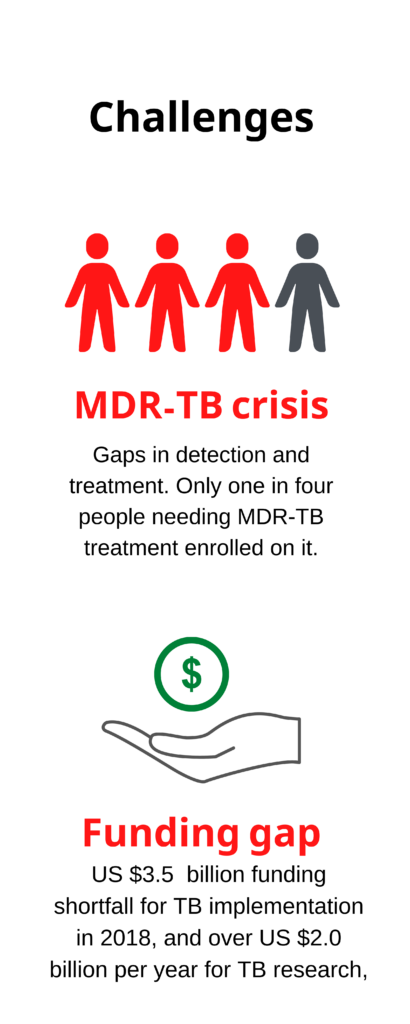Overview
The World Health Organization (WHO) recommends initial diagnostic tests for adults and children presenting TB symptoms to achieve its End TB Strategy to end the global epidemic by 2035. Too many undetected patients have a higher risk of transmitting the disease and may suffer distress and economic hardship.
Early detection of tuberculosis disease is critical to initiate the proper and timely treatment. Rapid and accurate diagnosis with a point of care (POC) test does not require extensive laboratory infrastructure and can reach low resource communities.
Point-of-care testing (POCT) offers multiple advantages to resource-limited communities including:
- Fast and simple specimen handling.
- No additives.
- No transportation.
- Diagnosis in less than an hour.

What is Tuberculosis?
Tuberculosis (TB) is the world’s top infectious killer infecting 10 million people every year and is caused by the bacteria Mycobacterium tuberculosis. TB is spread through the air when a person with lung TB cough, sneeze, or spit, propelling the TB bacteria into the air.
Every year people are infected with TB, with 1.5 million deaths worldwide. Globally, TB is one of the top causes of death and the leading cause from a single infectious agent (above HIV/AIDS).
Who is at risk?
Tuberculosis primarily affects adults, but all age groups are at risk, with over 95% of cases and deaths in developing countries.
People with a compromised immune system, including people living with HIV, malnutrition, or diabetes, or people who use tobacco, have a higher risk of falling ill with TB.
Symptoms

Cough

Cough with blood

Chest pain

Night sweats

Fever

Weight Loss
Treatment and Challenges
Treatment
TB is a treatable and curable disease with a six-month course of antibiotics provided to the patient with information, supervision, and support by a health worker or trained volunteer. Recent treatment options have shortened the duration to treat TB to only one or three months.
Common drugs include rifampicin and isoniazid. In some cases, the patient has drug-resistant TB, which requires prolonged treatment.
Challenges
Tuberculosis disease testing is critical for better diagnosis and treatment. Drug-resistant tuberculosis (DR-TB) poses a staggering threat to global public health. At least 75% to 80% of DR-TB is primarily airborne transmitted from person to person. Globally, we face a situation in which multidrug-resistant (MDR-TB) and extensively resistant (XDR-TB) is spreading virtually undetected via airborne transmission, threatening any progress made to reduce TB.
The widespread transmission will result in a significant loss of life and have global economic impacts. Despite international efforts, the WHO End TB Strategy will not meet any of the 2020 goals set for incidence, death, or cost. Further exacerbating this problem is the current COVID-19 global pandemic.
The WHO estimates that a decline in available healthcare resources in many countries has resulted in 25-30% fewer TB cases being diagnosed and treated, which could result in an additional 0.2 to 0.4 million deaths. A decline in diagnoses at a time when milestone targets are not being met is not only jeopardizing the WHO eradication strategy but may result in an unstoppable epidemic.
Solution
TB represents a threat worldwide and the need for an inexpensive, rapid, and widespread DR-TB diagnosis, especially in low-income and remote settings. The World Health Organization (WHO) recommends the use of rapid diagnostic tests as the initial diagnostic test in all persons with signs and symptoms of TB to the early detection of TB.
Our product is designed to meet or exceed the WHO target product profile for a community-based triage test and meet the WHO ASSURED (Affordable, Sensitive, Specific, User-friendly, Rapid and robust, Equipment-free, and Deliverable to end-users) criteria for diagnostics used in resource-constrained settings.
Our solution is to provide a diagnostic test that does not require processing or sample pre-treatment steps with results within 10 minutes, allowing to treat the patient before leaving the clinic.
REFtb Technology
The Reporter Enzyme Fluorescence technology (REFtb) uses fluorescence to track, detect, and diagnose infectious agents with greater sensitivity than existing technologies. It will meet the WHO target product profile for an inexpensive, simple, sputum-based point-of-care (POC) DST, and it requires minimal training.
REFtb-DST relies on the enzymatic activity of the TB beta-lactamase (BlaC) that depends on ATP levels for secretion and will detect drug resistance regardless of the nature of the mutation.
In addition, REFtb detects the viability of intact Mtb due to the requirement of ATP for BlaC secretion and does not require bacterial replication to obtain a positive signal, making REF useful for true drug-susceptibility testing (DST).
What is BlaC?
BlaC is a β-lactamase enzyme secreted when the bacteria are grown under laboratory conditions. It is used as a biomarker with BlaC-specific fluorogenic substrates for rapid and accurate detection of very low numbers of M.tuberculosis in clinical diagnosis.
How does REFtb works?
How does it work?
The REFtb system consists of:
- Sputum collector to obtain the patient sputum sample
- Reagent system
- Reader
The REFtb reagent mix contains buffer and reagents to counter known sputum inhibitors of the assay.
Our technology will be portable and battery-operated to be used in low-resource settings without proper laboratory infrastructure.
In addition, REFtb detects the viability of intact Mtb due to the requirement of ATP for BlaC secretion and does not require bacterial replication to obtain a positive signal, making REF useful for true drug-susceptibility testing (DST).
Email: [email protected]
Created by www.sugeilyramos.com